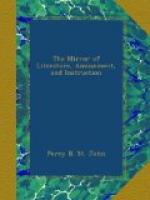The success of Miss Edgeworth’s delineations of Irish life, and the author’s completion of Mr. Strutt’s romance of Queen Hoo Hall, in 1808, again drew his attention to Waverley. Accident threw the lost sheets in his way, while searching an old writing-desk for some fishing-tackle for a friend. The long-lost manuscript presented itself, and “he immediately set to work to complete it, according to his original purpose.” Among other unfounded reports, it has been said, that the copyright was, during the book’s progress through the press, offered for sale to various booksellers in London at a very inconsiderable price. This was not the case. Messrs. Constable and Cadell, who published the work, were the only persons acquainted with the contents of the publication, and they offered a large sum for it, while in the course of printing, which, however, was declined, the author not choosing to part with the copyright. Waverley was published in 1814: its progress was for some time slow, but, after two or three months its popularity began to spread, and, in a short time about 12,000 copies were disposed of. The name of the author was kept secret from his desire to publish the work “as an experiment on the public taste. Mr. Ballantyne, who printed the novel, alone corresponded with the author; the original manuscript was transcribed under Mr. Ballantyne’s eye, by confidential persons; nor was there an instance of treachery during the many years in which these precautions were resorted to, although various individuals were employed at different times. Double proof sheets were regularly printed off. One was forwarded to the author by Mr. Ballantyne, and the alterations which it received were, by his own hand, copied upon the other proof-sheet for the use of the printers, so that even the corrected proofs of the author were never seen in the printing-office; and thus the curiosity of such eager inquirers as made the most minute investigation was entirely at fault."[11]
[11] Abridged from the General Preface, &c.




